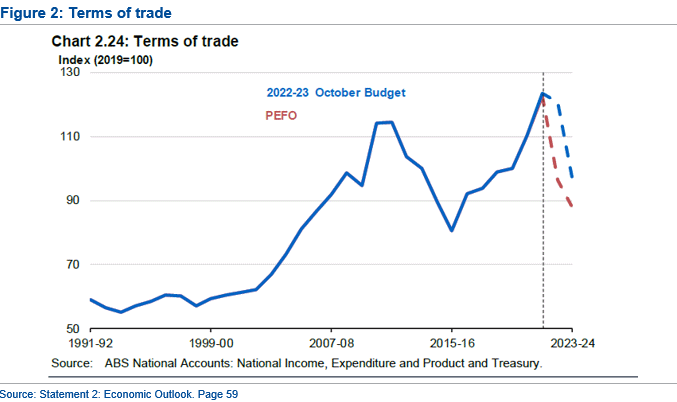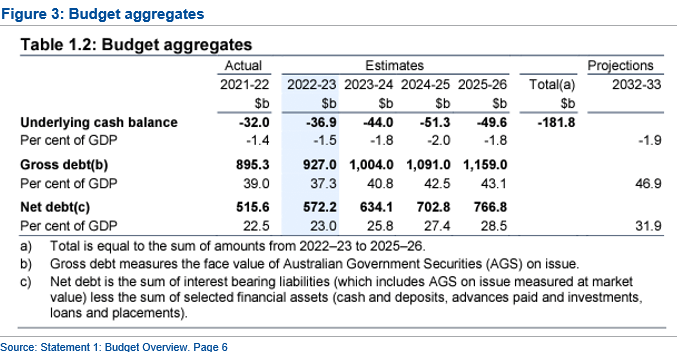In recent weeks, I have spent much time looking at the extremely difficult issues confronting European economies. Here we see real crisis. Here we see major economies facing the strife caused by major slumps in their terms of trade. Important resources are difficult to get. Their economies and their populations are faced by genuine hardship made worse by the approach of winter.
How different it is to look at the Australian economy painted by these budget papers. This is a rich and prosperous economy in the midst of a major commodities boom. This is an economy benefiting from a major rise in its terms of trade, precisely the reverse of the terms of trade slump suffered in Europe. The Treasurer's greatest hardship seems to be the problem of distributing the benefits of Australia's strong terms of trade.

Advertisement
In Figure 1 above, we see the major economic parameters provided to us in Budget Paper No 1, page 6. Growth in the financial year just past was a very strong 3.9%. Growth in the financial year we are in now is 3.25%. Even when growth slows in 2023/2024, it is still a positive 1.5%. No recession here. Growth then recovers in 2024/2025 to 2.25% and again in 2025/2026 to 2.5%.
Unemployment does rise as we move towards 2023/2024 but it peaks at 4.5% in 2024/2025. Australian policy makers have been trying to get unemployment below 4.5% for most of the past two decades. It is hardly a problem if this is the peak level to which unemployment may now rise.
The CPI is a problem in Australia but not a problem of the scale that faces European economies. The CPI is about to peak at the end of calendar 2022 and then begin to decline. The budget papers suggest by mid 2023, CPI inflation will fall in Australia to 5.75%. It will fall to 3.5% a year later. By 2023/2024, inflation will be back safely in the RBA target range of 2-3%.
Inflation may be falling, but wage growth finally catches up with inflation in 2023/2024 and then sprints ahead faster than inflation over following years. This means wages are expected to rise in real terms. Living standards are expected to improve.
The miracle that drives this prosperity within the Australian economy is captured by the terms of trade. We see this in Figure 2, drawn from Statement 2, page 59. Australia is receiving much higher prices for what it sells compared to what it buys. The terms of trade, as it currently stands on this chart, is the highest that has been recorded in Australian economic history. We see that the budget papers suggest these prices will fall in the future. Budget papers are notoriously conservative about future prices. We should note that even if the terms of trade did fall as rapidly as the budget papers suggest, they would still be much higher than they were in 2015/2016 and very much higher than they were in the 1990s.

Advertisement
The beneficial circumstances that the Australian economy finds itself in are reflected in improvement in the budget balance. A budget deficit of $36.9 billion in 2022/2023 is only 1.5% of Australian GDP. Even as the outlook worsens in 2024/2025, the budget deficit only widens to 2% of GDP. For the same period, the US budget deficit looks like widening to near 4% of GDP. These are still very good numbers, and they are extremely good numbers in the situation of the expanded welfare programs contained in this budget.

The information contained in this report is provided to you by Morgans Financial Limited as general advice only, and is made without consideration of an individual’s relevant personal circumstances. Morgans Financial Limited ABN 49 010 669 726, its related bodies corporate, directors and officers, employees, authorised representatives and agents (“Morgans”) do not accept any liability for any loss or damage arising from or in connection with any action taken or not taken on the basis of information contained in this report, or for any errors or omissions contained within. It is recommended that any persons who wish to act upon this report consult with their Morgans investment adviser before doing so. Those acting upon such information without advice do so entirely at their own risk.
This report was prepared as private communication to clients of Morgans and is not intended for public circulation, publication or for use by any third party. The contents of this report may not be reproduced in whole or in part without the prior written consent of Morgans. While this report is based on information from sources which Morgans believes are reliable, its accuracy and completeness cannot be guaranteed. Any opinions expressed reflect Morgans judgement at this date and are subject to change. Morgans is under no obligation to provide revised assessments in the event of changed circumstances. This report does not constitute an offer or invitation to purchase any securities and should not be relied upon in connection with any contract or commitment whatsoever.
Discuss in our Forums
See what other readers are saying about this article!
Click here to read & post comments.
13 posts so far.